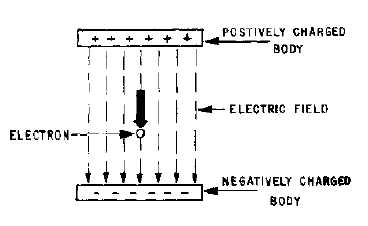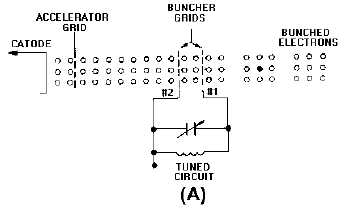2-6
Figure 2-3.—Moving electron losing energy and velocity.
The operation of a velocity-modulated tube depends on a change in the velocity of the electrons
passing through its electrostatic field. A change in electron velocity causes the tube to produce
BUNCHES of electrons. These bunches are separated by spaces in which there are relatively few
electrons. Velocity modulation is then defined as that variation in the velocity of a beam of electrons
caused by the alternate speeding up and slowing down of the electrons in the beam. This variation is
usually caused by a voltage signal applied between the grids through which the beam must pass.
The first requirement in obtaining velocity modulation is to produce a stream of electrons which are
all traveling at the same speed. The electron stream is produced by an electron gun. A simplified version
of an electron gun is shown in figure 2-4A. Electrons emitted from the cathode are attracted toward the
positive accelerator grid and all but a few of the electrons pass through the grid and form a beam. The
electron beam then passes through a pair of closely spaced grids, called BUNCHER GRIDS. Each grid is
connected to one side of a tuned circuit. The parallel-resonant tuned circuit (figure 2-4A) in the
illustration represents the doughnut-shaped resonant cavity surrounding the electron stream (figure 2-4B).
The buncher grids are the dashed lines at the center of the cavity and are at the same dc potential as the
accelerator grid. The alternating voltage which exists across the resonant circuit causes the velocity of the
electrons leaving the buncher grids to differ from the velocity of the electrons arriving at the buncher
grids. The amount of difference depends on the strength and direction of the electrostatic field within the
resonant cavity as the electrons pass through the grids.
Figure 2-4A.—Electron gun with buncher grids.





